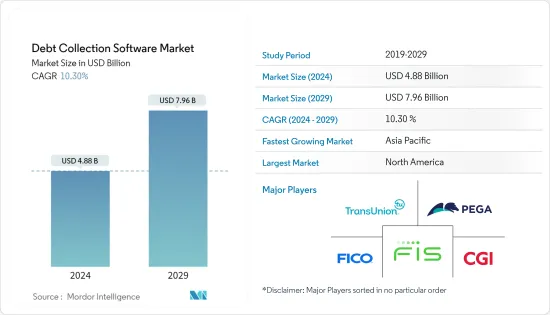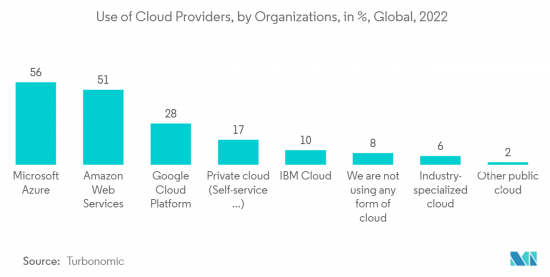PUBLISHER: Mordor Intelligence | PRODUCT CODE: 1406187

PUBLISHER: Mordor Intelligence | PRODUCT CODE: 1406187
Debt Collection Software - Market Share Analysis, Industry Trends & Statistics, Growth Forecasts 2024 - 2029

The Debt Collection Software Market size is estimated at USD 4.43 billion in the current year and is expected to reach USD 7.19 billion by the end of the forecast period by registering a CAGR of 10.17% during the forecast period.
Key Highlights
- The increase in regulatory compliance requirements, such as the Payment Card Industry Data Security Standard (PCI DSS), Health Information Technology for Economic and Clinical Health (HITECH), and the Health Insurance Portability and Accountability Act, is a major factor driving the adoption of debt collection software across several industry verticals. As huge corporations expand their operations geographically, they come under the scrutiny of several regulatory organizations.
- Accounts receivable are legally enforceable claims businesses hold for items or services purchased by end customers but not yet paid for. The drive for automation has been fueled by the need to speed up day-to-day operations by offloading labor-intensive administrative duties to technology. The market for debt collection software is expected to increase as automation of accounts receivable operations facilitates the shift of invoicing activities to digital practices. Furthermore, automating the debt collection and recovery process improves debt collection efficiency by methodically identifying the causes and reducing the time required to handle the cases.
- Further, the automated debt collection solutions market is predicted to rise dramatically as organizations that collect debts are pressured to decrease costs while improving operations and boosting income. This component is expected to significantly contribute to the growth of the global market for debt collection software. Furthermore, automating the debt collection process eliminates the need for spreadsheets and frees up resources to focus on revenue-generating activities. Again, using intelligent automated techniques makes it easier to maintain consistent communication, deliver bills quickly, follow up on leads, calculate and analyze key performance indicators (KPIs), and retain critical data in a single area.
- Predictive analytics has emerged as a crucial enabler that assists in categorizing clients based on their attributes and developing customized debt management and advice programs for each customer segment. It integrates approaches to debt collection, such as data mining, machine learning, artificial intelligence, and statistical modeling. Furthermore, big data analytics makes gathering critical information about debtors easier. Demographic data or behavioral aspects, such as the time a debtor will respond to a call, can substantially impact the success of debt collection calls.
- Enhancements to software for introducing new features and the obligation to maintain the program up-to-date contribute to a rise in maintenance expenses. Furthermore, debt collection software requires the entry of a large amount of data; hence, faulty implementation can take years. While problems linked to software deployment with an organization's IT infrastructure can be time-consuming and costly, it delays the anticipated return on investment from this product.
- The economic stress caused by the pandemic caused millions of people to incur enormous debt. As a result, governments amended and strengthened existing legislation to safeguard debt-ridden households and enterprises. In the United States, the Fair Debt Collection Practices Act (FDCPA) enacted an Interim Final Rule (IFR) that updated Regulation F to safeguard customers from being misled into believing they are ineligible for interim protection from eviction due to insolvency. This may have created an opportunity for the market to grow.
Debt Collection Software Market Trends
Increasing Automation in the Debt Collection Process to Drive the Growth
- According to the Flexera 2022 State of the Cloud Report, migrating workloads to the cloud was widespread across industries. This is especially significant in financial services, where it was the top cloud initiative for 2022. 62% percent of the 154 survey respondents from financial services businesses said they intend to make progress on this measure in the future year. This workload movement indicates growing trust in cloud providers' security capabilities and policies to provide adequate protection.
- Further, one-third (33%) of financial services organizations anticipate using a mix of on-prem and cloud/software-as-a-service (SaaS) for corporate financial data. Even more (35%) anticipate utilizing a mix of on-premise and cloud/SaaS for consumer data, such as personally identifiable information (PII) and protected health information (PHI). 44% of financial services or organizations' data is in the cloud, a number expected to grow to 52% in the coming year.
- Similarly, 78% of financial services businesses run workloads on Amazon Web Services (AWS), while 76% run workloads on Azure, virtually placing these two public clouds on a level. Google Cloud Platform ranks third, with 43% of financial services businesses running workloads on it. Regarding where the instances operate, 46% of financial services firms use more than 100 instances in AWS, while 51% of financial services organizations run more than 100 instances in Azure. 22% of financial services businesses spend more than USD 6 million per year on AWS, whereas 18% spend more than USD 6 million per year on Azure.
- The public cloud allows users to store and process their data, along with various capabilities that share resources to achieve economies of scale in third-party data centers. Using public cloud platforms signifies that the users can use the same services without concern about data storage and management. These are useful for organizations in reducing the potentially expensive costs of purchasing, managing, and maintaining the on-premises software. These cloud services are usually offered through an automated online channel independent of human interaction. Since these services require low fixed costs and are scalable, they are well-suited for local governments. Public clouds are much closer to government agencies, owing to their benefits, such as cost and pay-as-you-go models.
- Public entities operate in traditional IT environments where most of the work is accomplished through keyboard entries, manual labor & opening tickets. In the public cloud, the software can configure and deploy services and manage all life cycle phases, whether deploying a new server or a new network component. Moving to a software-defined environment allows organizations to do things quicker and with more agility in a way that is more predictable, repeatable, auditable, and testable.

North America is Expected to Hold Significant Share
- The North American region poses significant opportunities for the growth of the debt collection software market. The region has been facing several challenges in terms of debt recovery. Even if American student loans were to be excused or restructured, there would still be trillions of dollars left to be repaid in the United States alone. Yet, the debt collection industry has seen little of the past decade's fintech revolution.
- According to Northwestern Mutual, In 2022, 18% of US consumers claimed their primary source of debt was their home mortgage, while 20% said credit card debt was their primary source of debt. Further, according to the International Monetary Fund (IMF), in Q1 2022, the United States's household debt amounted to nearly 75% of its GDP. Such a rise in debt would push financial service firms and banks to adopt the debt software market. This may create an opportunity for the market players to develop new solutions to capture market share.
- In May 2022, Payix, a REPAY company and a nationwide player in borrower-facing collections and communications tools, announced the expansion of its exclusive partnership with Nortridge Software, a leading software provider for lenders and loan servicing companies, to provide Nortridge clients with online cash payment acceptance, or eCash. eCash simplifies payment acceptance by allowing borrowers to make loan payments in cash at thousands of partner retail outlets, including major convenience stores, dollar stores, and pharmacies.
- Increased demand for self-service payment models in the region is a critical factor driving market growth, as is the increased prevalence of integrated debt collection software and the need to improve debt recovery rates and reduce bad debts by managing different debt categories, among other factors driving the debt collection software market. Furthermore, technical developments and modernization of production procedures will generate new chances for the debt collection software market throughout the forecast period.
- Debt collection laws are the primary regulators of debt collection agencies, creditors, and other debt recovery agents' operations. Debt collection software makes compliance with industry-specific regulatory norms and laws possible. The program supports compliance management through document control, compliance training, ongoing audits, and the recording and reporting of exception occurrences and corrective actions. The necessity for regulatory compliance drives greater investments in debt collection software.
Debt Collection Software Industry Overview
The debt collection software market is fragmented. The degree of fragmentation will accelerate during the forecast period as the various industries are experiencing a massive transformation due to technological advancement, and the players compete to provide the best solution. Some of the recent developments in the market are:
In November 2022, FICO and IMTF entered an exclusive contract for essential software and intellectual property. This makes it possible for IMTF to enhance and expand the Siron Suite and provide global support for the apps and associated software-as-a-service (SaaS) offerings. FICO will transfer all customer relationships and commitments related to Siron to IMTF as part of the transaction.
In February 2022, Sila Inc., a fintech software platform that provides payment infrastructure, announced a partnership with TrueAccord, the leading debt collection company offering intelligent, digital-first collection and recovery solutions, to make TrueAccord's products and services more accessible to Sila's customers. Dealing with overdue and defaulted accounts is a critical component that fintechs must have in their overall fund management. TrueAccord delivers a tailored, self-service experience that fosters consumer engagement and industry-leading results by leveraging a unique machine-learning engine and engagement data from millions of customers.
Additional Benefits:
- The market estimate (ME) sheet in Excel format
- 3 months of analyst support
TABLE OF CONTENTS
1 INTRODUCTION
- 1.1 Study Assumptions and Market Definition
- 1.2 Scope of the Study
2 RESEARCH METHODOLOGY
3 EXECUTIVE SUMMARY
4 MARKET INSIGHT
- 4.1 Market Overview
- 4.2 Industry Attractiveness - Porter's Five Forces Analysis
- 4.2.1 Bargaining Power of Suppliers
- 4.2.2 Bargaining Power of Consumers
- 4.2.3 Threat of New Entrants
- 4.2.4 Threat of Substitutes
- 4.2.5 Intensity of Competitive Rivalry
- 4.3 Assessment of Impact of COVID-19 on the Global Debt Collection Software Market
5 MARKET DYNAMICS
- 5.1 Introduction to Market Dynamics
- 5.2 Market Drivers
- 5.2.1 Increasing Automation in the Debt Collection Process to Drive the Growth
- 5.2.2 Outsourcing Debt Recovery to Specialized Debt Collection Agencies
- 5.3 Market Restraints
- 5.3.1 Inadequacy of Legacy Systems
6 MARKET SEGMENTATION
- 6.1 By Deployment
- 6.1.1 Cloud-based
- 6.1.2 On-premise
- 6.2 By Organization Size
- 6.2.1 Large Enterprises
- 6.2.2 Small and Medium-sized Enterprises
- 6.3 By End User
- 6.3.1 Financial Institutions (Banks and NBFC)
- 6.3.2 Collection Agencies
- 6.3.3 Healthcare
- 6.3.4 Government
- 6.3.5 Telecom and Utilities
- 6.3.6 Other End Users (Real Estate and Retail)
- 6.4 Geography
- 6.4.1 North America
- 6.4.2 Europe
- 6.4.3 Asia-Pacific
- 6.4.4 Latin America
- 6.4.5 Middle East & Africa
7 COMPETITIVE LANDSCAPE
- 7.1 Company Profiles
- 7.1.1 Fidelity National Information Services Inc. (FIS)
- 7.1.2 CGI Inc.
- 7.1.3 Fair, Isaac and Company (FICO)
- 7.1.4 TransUnion LLC
- 7.1.5 Pegasystems Inc.
- 7.1.6 Temenos AG
- 7.1.7 Intellect Design Arena
- 7.1.8 Nucleus Software Exports Ltd.
- 7.1.9 Chetu Inc.
- 7.1.10 AMEYO
- 7.1.11 EXUS
- 7.1.12 KuhleKT Pty Ltd.
8 INVESTMENT ANALYSIS
9 FUTURE OF THE MARKET




